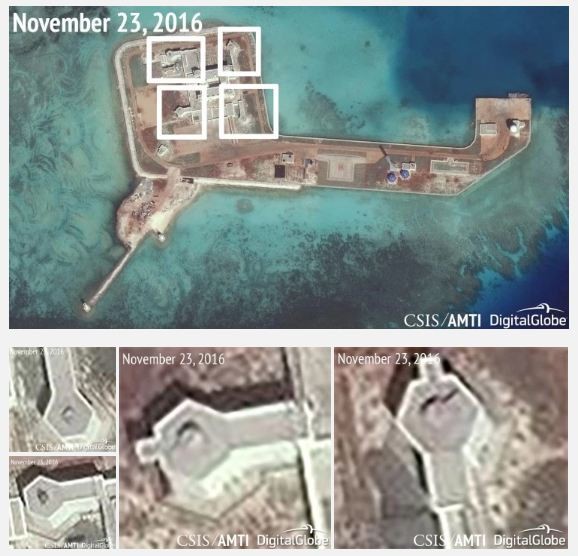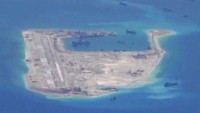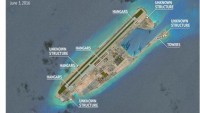China Confirms Deploying Short-range Air Defense Weapons on Spratly Islands
| Arthur Dominic Villasanta | | Dec 15, 2016 10:29 PM EST |
(Photo : AMTI) Anti-aircraft emplacements on Hughes Reef (boxes show location of weapons).
(Photo : AMTI) Anti-aircraft emplacements on Johnson Reef (boxes show location of weapons).
China admitted to deploying short-range air defense weapons, including anti-aircraft artillery, but apparently no long-range surface-to-air missiles and radar systems in the disputed Spratly Islands claiming it has the legitimate right to do so.
"As for necessary military facilities, they are primarily for defense and self-protection, and this is proper and legitimate," said a statement from China's Ministry of Defense.
Like Us on Facebook
"For instance, if someone was at the door of your home, cocky and swaggering, how could it be that you wouldn't prepare a slingshot?"
The ministry said weapons and military systems on the islands are reasonable. It repeated China's claim its construction on the islands is mainly for civilian purposes.
China's admission came three days after a number of incriminating satellite photos showed new weapons being deployed on Subi Reef and other Chinese controlled reefs.
It was further proof that China's true aim is to turn the islands it seized in the South China Sea into military bases and not as civilian outposts, as has been claimed by some military analysts.
The building of more capable anti-air "point defense systems" was spotted on Gaven, Hughes, Johnson, and Cuarteron Reefs, among others.
The Center for Strategic and International Studies in Washington two days ago released the images of the new fortifications through its Asia Maritime Transparency Initiative (AMTI). The images showed "large antiaircraft guns and probable close-in weapons systems," aimed at engaging cruise missile.
AMTI said China appears to have built significant point-defense capabilities by deploying "large anti-aircraft guns" of an unknown type and probably close-in weapons systems (CIWS) at each of its outposts in the Spratlys.
It said the reinforcement "show that Beijing is serious about defense of its artificial islands in case of an armed contingency in the South China Sea.
"Among other things, they would be the last line of defense against cruise missiles launched by the United States or others" against air bases that on the islands.
China's admission to militarization will complicate its already strained relations with President-elect Donald Trump, a month before his inauguration as President.
AMTI said it began tracking the construction of identical, hexagon-shaped structures at Fiery Cross, Mischief and Subi Reefs in June and July.
"It now seems that these structures are an evolution of point-defense fortifications already constructed at China's smaller facilities on Gaven, Hughes, Johnson, and Cuarteron Reefs'," said AMTI in a report.
AMTI noted China has built nearly identical headquarters buildings at each of its four smaller artificial islands. The two smallest of the islets, Hughes and Gaven Reefs, feature four arms radiating from these central structures.
The end of each of these arms sports a hexagonal platform, approximately 30 feet wide. The northeastern and southwestern arms host what are most likely anti-aircraft guns (roughly 20 feet long when measured to the tip of the barrel).
AMTI noted that China modified this blueprint for its base on Johnson Reef.
"There the central facility has only two arms, with the southern one sporting the same anti-aircraft gun (which is covered by a tarp in recent imagery but was previously visible) and the northern one an apparent CIWS.
Another gun and probable CIWS, along with a radar, were constructed on a separate structure, consisting of three hexagonal towers on the eastern side of the artificial island. This structure seems to be a less complex precursor to those built more recently at Fiery Cross, Mischief, and Subi Reefs."
At Cuarteron Reef, the last of the four smaller artificial islands completed, the point-defense systems have been completely separated from the central headquarters building.
The northeastern and southwestern ends of the islet each host a structure identical to the one built at Johnson, including an anti-aircraft gun, probably a CIWS, and radar.
This model has gone through another evolution at China's much-larger bases on Fiery Cross, Subi, and Mischief Reefs. Each of these sports four structures, consisting of tiered hexagonal towers oriented toward the sea.
They are positioned so that any anti-aircraft guns and CIWS installations placed on them would cover all approaches to the base with overlapping fields of fire.
Tagschina, spratly islands, militarization, anti-aircraft guns, CIWS
©2015 Chinatopix All rights reserved. Do not reproduce without permission
EDITOR'S PICKS
-

Did the Trump administration just announce plans for a trade war with ‘hostile’ China and Russia?
-

US Senate passes Taiwan travel bill slammed by China
-

As Yan Sihong’s family grieves, here are other Chinese students who went missing abroad. Some have never been found
-

Beijing blasts Western critics who ‘smear China’ with the term sharp power
-

China Envoy Seeks to Defuse Tensions With U.S. as a Trade War Brews
-

Singapore's Deputy PM Provides Bitcoin Vote of Confidence Amid China's Blanket Bans
-

China warns investors over risks in overseas virtual currency trading
-

Chinese government most trustworthy: survey
-

Kashima Antlers On Course For Back-To-Back Titles
MOST POPULAR
LATEST NEWS
Zhou Yongkang: China's Former Security Chief Sentenced to Life in Prison

China's former Chief of the Ministry of Public Security, Zhou Yongkang, has been given a life sentence after he was found guilty of abusing his office, bribery and deliberately ... Full Article
TRENDING STORY

China Pork Prices Expected to Stabilize As The Supplies Recover

Elephone P9000 Smartphone is now on Sale on Amazon India

There's a Big Chance Cliffhangers Won't Still Be Resolved When Grey's Anatomy Season 13 Returns

Supreme Court Ruled on Samsung vs Apple Dispute for Patent Infringement

Microsoft Surface Pro 5 Rumors and Release Date: What is the Latest?














